Welcome to our blog post on the remarkable growth of fish farming in Nigeria and the essential rules to kickstart your venture from scratch. As the demand for fish products continues to rise, the Nigerian aquaculture industry offers immense opportunities for entrepreneurs.
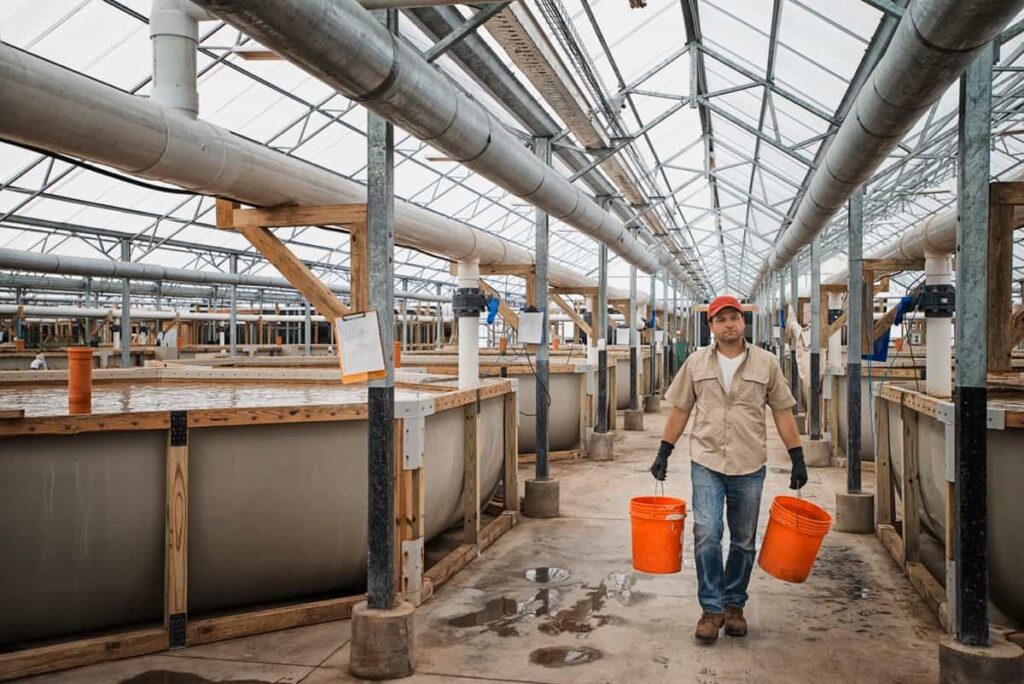
This engaging guide will provide accurate data and easy-to-read information to help you navigate the key rules of starting a successful fish farming business. We’ve covered you, from site selection and pond construction to choosing the right fish species and marketing strategies. Get ready to dive into the exciting world of fish farming in Nigeria!
Fish Farming in Nigeria
What is Fish Farming in Nigeria?
Fish farming, or aquaculture, refers to raising fish in controlled environments for commercial purposes in Nigeria. It involves constructing ponds or tanks and carefully managing water conditions to support fish growth. Fish farmers in Nigeria rear various species like catfish, tilapia, and carp. This method provides a sustainable way to meet the increasing demand for fish, create employment opportunities, and contribute to the country’s food security and economic development.
Rising of Fish in Nigeria: Key Rules to Start
To start a fish farming business in Nigeria, conduct thorough research on fish species market demand and profitability. Additionally, obtaining the necessary permits and licenses from the Ministry of Agriculture and other relevant agencies is essential for legal operation.
Selecting an appropriate location with ample water supply, accessibility, and infrastructure is vital. Construct well-designed fishponds with proper sealing and water circulation to ensure a conducive environment for the fish. Stock the ponds with suitable fingerlings or fish juveniles and implement a balanced feeding regimen.
Monitoring and maintaining water quality through aeration and filtration systems are important for fish health. Implement measures to control and protect fish from predators. Plan efficient fish harvesting techniques based on pond size and species.
In case you missed it: The Rise of Fish Farming in Kenya: Key Rules to Start from Scratch
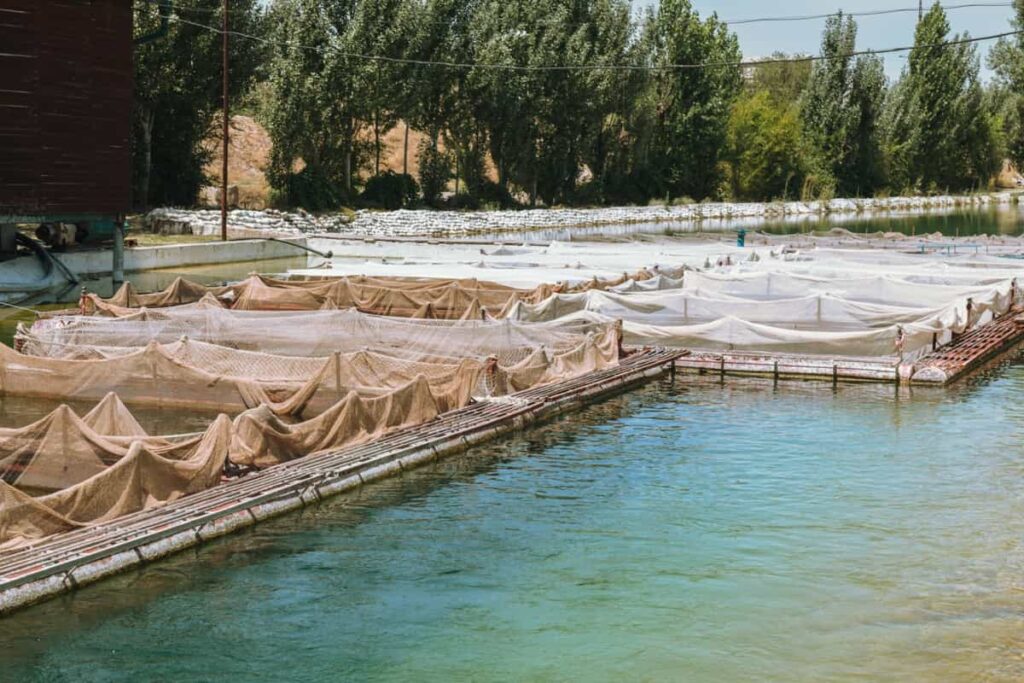
Objectives of Fish Farming in Nigeria
- Money Making: Fish farming is seen as a lucrative occupation, allowing fish farmers to generate significant profits from selling and marketing fish.
- Economic Boost: Fish farming activities can benefit coastal areas and communities by creating employment opportunities and supporting related industries.
- Food Production: Fish farming helps meet the demand for fish as a food source in Nigeria, making it more accessible to the public.
- Species Protection: Fish farming protects fish species from overfishing and the risk of extinction, ensuring their sustainability.
Types of Fish Farming in Nigeria
- Catfish Farming: Catfish is Nigeria’s most commonly reared fish species due to its popularity in African meals. It is easy to cultivate and has high demand in the market.
- Tilapia Fish Farming: Tilapia is Nigeria’s second most popular fish species. It grows quickly, survives in poor water quality, and is profitable for fish farmers.
- Salmon (Mackerel) Farming: Salmon, known as “Titus” in Nigeria, is a widely consumed fish species that can be caught in the wild or cultivated on fish farms.
- The cost of starting a fish farm depends on the scale of the operation.
- A rough estimate for starting from scratch ranges from Five Hundred Thousand Naira (N500,000) to about One Million Naira (N1,000,000) in Nigeria.
- Key expenses include land acquisition, pond construction, electricity for water pumping, business plan development, and purchasing or hatching fingerlings.
- Other costs involve plumbing infrastructure for water supply and drainage.
Equipment and Infrastructure
- Land: Acquiring suitable land for the fish farm is essential, and the cost may vary depending on the location.
- Pond Construction: Building ponds of different sizes are required, with costs varying based on the type of pond (ground or block) and the number of ponds.
- Electricity for Water Pumping: Access to a reliable source of electricity is important for pumping and removing water from the ponds.
- Buying or Hatching Fingerlings: Acquiring small fish (fingerlings) for breeding is an expense.
- Plumbing: Proper plumbing infrastructure, including boreholes and tanks, is necessary for water supply and pond circulation.
In case you missed it: Project Report of Pangasius Fish Farming: Cultivation Economics, Production Cost, and Profit Analysis
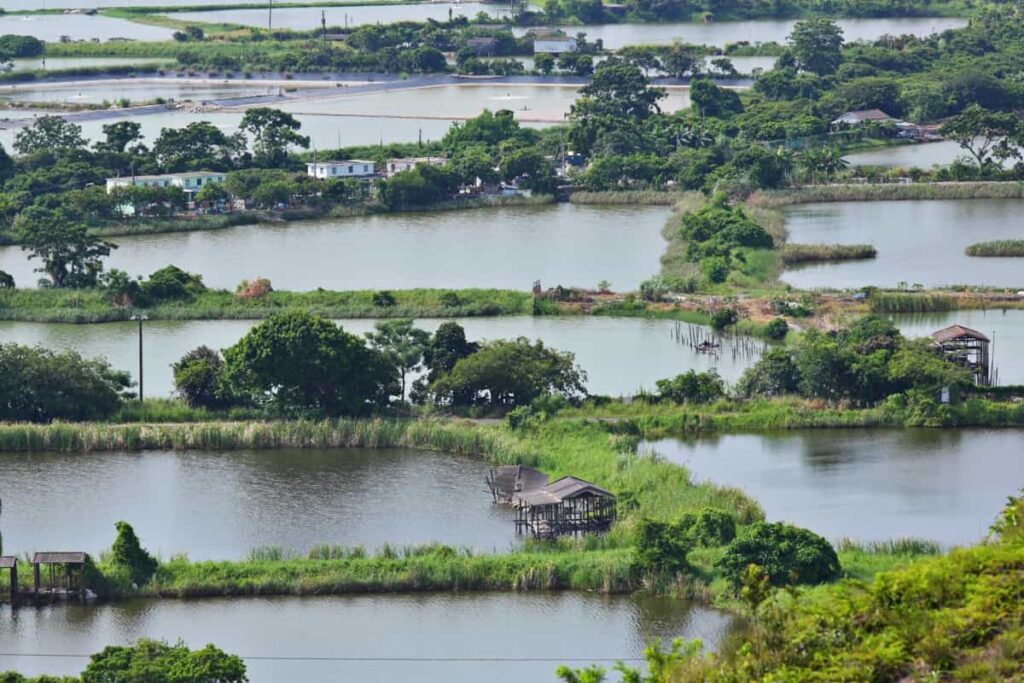
Things to Know About Fish Farming Business in Nigeria
Craft a Comprehensive Business Plan: Writing a business plan is crucial and should be your first step. It involves conducting a feasibility study, setting goals, performing market research, and documenting essential information like executive summary, products and services, location, market strategy, financial projections, and expansion plans.
Register your business: Registering your fish farming business with the Corporate Affairs Commission (CAC) provides official recognition and access to benefits tailored for registered businesses in Nigeria.
Obtain Proper Training: Acquiring knowledge, technical skills, and training is essential for success in fish farming. Seek expert guidance, learn as an apprentice, enroll in online courses, read books, and conduct thorough research to understand fish health, disease prevention, medication administration, and effective farm management.
Find a Suitable Location for Your Fish Pond: Choose a location that accommodates your requirements. Fish farming doesn’t cause an environmental disturbance, so that you can select a space. You can rent, buy land, or utilize available space in your compound.
Construct the Fish Pond, Borehole, and Overhead Tank: Consult experts to determine the best pond type for your farm based on location. Earthen, concrete, or plastic tank ponds are common choices. Additionally, you’ll need a borehole and overhead tank for water supply. Seek professional assistance to avoid costly mistakes.
Select the Appropriate Fish Species: Consider the weather and climate of Nigeria when choosing fish species. Catfish is popular due to its suitability for farming in Nigeria. Consult experts to identify the specific catfish species that thrive in your environment.
Purchase Fingerlings or Juveniles: To start your fish farm, acquire them from specialized fish farmers who hatch and sell them. Buying juveniles is recommended for beginners.
Choice of Right Fish Feed: Provide nutritious supplementary fish feed for optimal production. You can also incorporate low-cost conventional or unconventional animal by-products and plant residues. The fish feed can be categorized as natural feed (found in the pond), supplementary feed (locally available materials), or complete feed (carefully formulated and commercially produced).
Implement Effective Marketing Strategies: Promote your fish farming business by creating a website and social media handles and leveraging word-of-mouth. Approach restaurants, supermarkets, and other potential buyers to raise awareness about your products.
In case you missed it: Project Report of RAS Fish Farming: Production Economics, Cost, and Profit Analysis
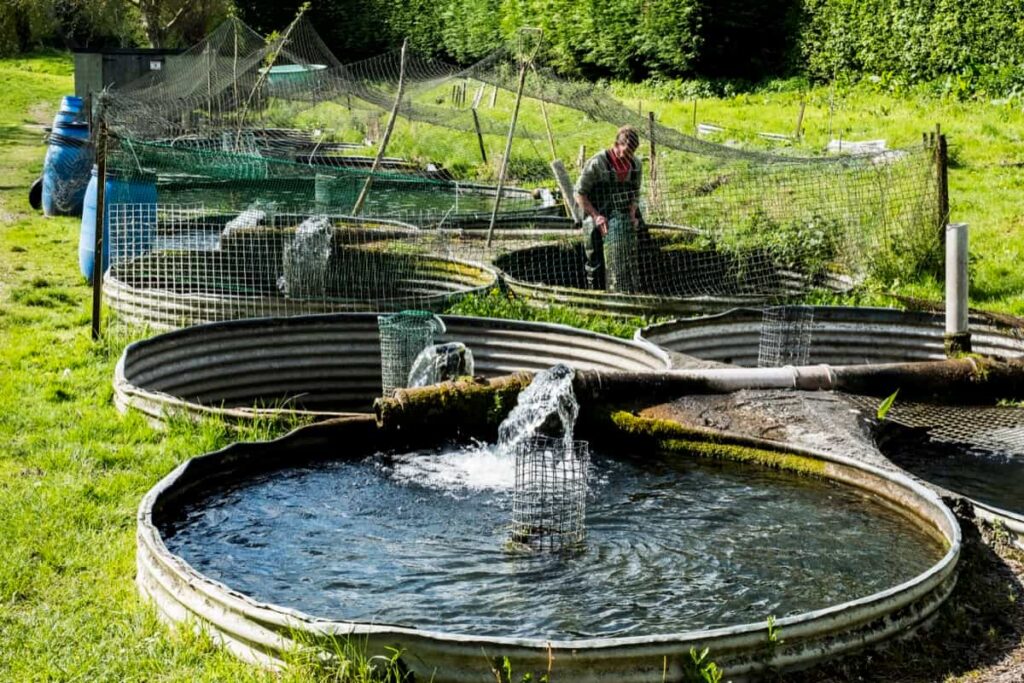
Profitability of Fish Farming in Nigeria
- Lucrative Business: Fish farming is a highly profitable venture in Nigeria, offering significant returns on investment for entrepreneurs.
- High Demand: There is a constant and increasing demand for fish in Nigeria due to its status as a staple food, making fish farming a sustainable and lucrative business.
- Favorable Climate: Nigeria’s tropical climate provides a conducive environment for fish farming, allowing fish to grow well and quickly.
- Low Cost of Production: Compared to other livestock farming, fish farming has relatively lower production costs, making it accessible to a wide range of investors.
- Quick Growth: Certain fish species, like catfish and tilapia, have rapid growth rates, leading to quicker turnover and higher profits.
- Multiple Income Streams: Fish farming generates income from selling live fish and processed fish products like smoked, dried, or canned fish.
- Government Support: The Nigerian government provides various incentives, grants, and loans to support fish farming, further enhancing its profitability.
- Export Opportunities: Nigeria’s fish farming industry has potential export opportunities, expanding the market and increasing profitability for farmers.
- Diverse Market Channels: Fish products can be sold through local markets, supermarkets, restaurants, and online platforms, diversifying sales channels for farmers.
- Scalability: Fish farming operations can be easily scaled up to meet growing demand, allowing for increased profits over time.
Fish Farming Equipment and Supplies in Nigeria
- Fish Tanks or Ponds: Fish tanks or ponds are essential for housing and raising fish in controlled environments. They come in various sizes and materials, such as concrete, earthen, or plastic tanks.
- Aeration Systems: Aeration systems provide oxygen to the water, ensuring optimal conditions for fish growth and health. Equipment like air pumps, diffusers, and aerators help maintain adequate oxygen levels.
- Filtration Systems: Filtration systems remove impurities and maintain water quality in fish tanks or ponds. They include mechanical, biological, and chemical filters to remove debris, ammonia, and harmful substances.
- Feeding Equipment: Feeding equipment includes automatic feeders, fish feed dispensers, and feeding trays to ensure regular and controlled fish feeding.
- Nets and Harvesting Tools: Nets transfer fish and harvest from the tanks or ponds. Harvesting tools such as fish graders, weighing scales, and fish counters assist in managing and measuring the fish population.
- Water Testing Kits: Water testing kits are essential for monitoring water parameters such as pH, ammonia, nitrate, and oxygen levels. They help ensure the water quality is suitable for fish health.
- Medications and Disease Control: Fish farming requires medications and disease control measures to prevent and treat common fish diseases. These may include antibiotics, antiparasitic treatments, and vaccines.
- Hatchery Equipment: Hatchery equipment is necessary for fish breeding and reproduction. It includes hatchery tanks, incubators, and breeding nets for properly managing fish eggs and fry.
- Water Circulation and Pumping Systems: Water circulation and pumping systems maintain proper water flow and exchange in fish tanks or ponds. They include pumps, pipes, and water distribution systems.
- Testing and Monitoring Devices: Testing and monitoring devices such as thermometers, pH meters, and dissolved oxygen meters help assess and regulate environmental conditions in fish farming.
In case you missed it: Project Report of Biofloc Fish Farming: Production Economics, Cost, and Profit Analysis
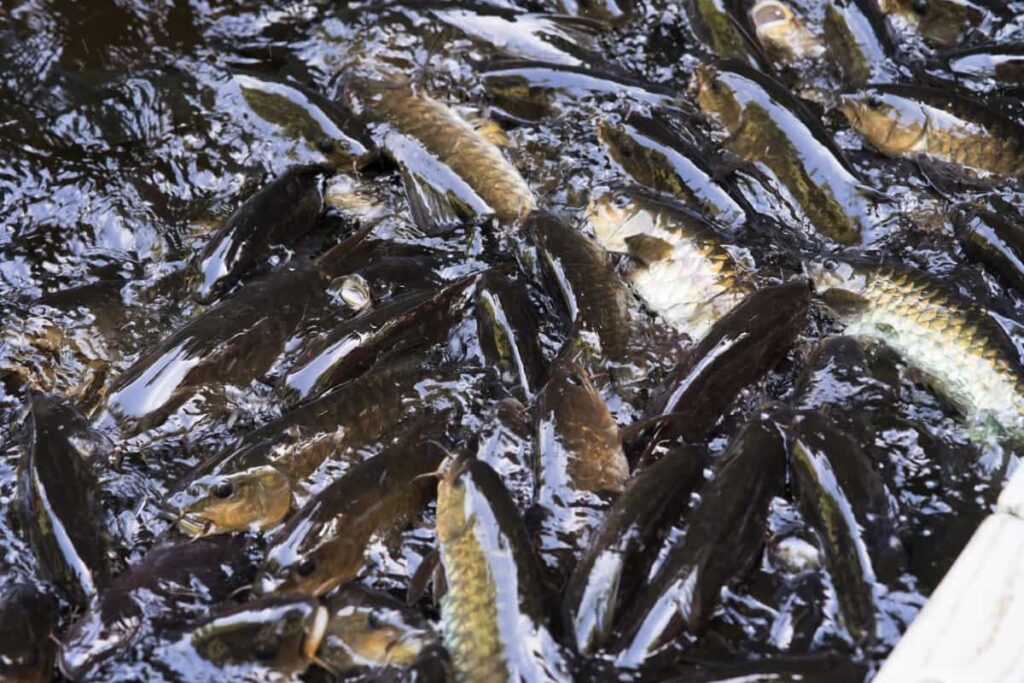
Best Fish Species for Farming in Nigeria
Catfish: Catfish is Nigeria’s most popular and widely reared fish species. It dominates the aquaculture industry due to its high demand and ease of cultivation. Catfish is a versatile fish in various African dishes, making it a preferred choice for homes, restaurants, and hotels. It is predominantly farmed in ponds, with the breeding of fingerlings and rearing of juveniles to maturity as key practices.
Tilapia: Tilapia ranks as the second most popular fish species in Nigeria. It is a freshwater fish in streams, ponds, rivers, and lakes, thriving in warm-water habitats. Tilapia is increasingly important in aquaculture worldwide due to its fast growth and ability to tolerate high stocking densities and suboptimal water quality. Fish farmers favor it for its profitability. Tilapia farming primarily occurs in freshwater systems like streams, ponds, and lakes.
Salmon (Mackerel): Salmons, known as “Titus” in Nigeria, are a widely consumed fish species in the country. They are both caught in the wild and cultivated on fish farms. Salmons are typically freshwater fish that migrate to the ocean and return to freshwater for spawning. They constitute a significant portion of the fisheries products consumed in Nigeria.
Government Regulations and Permits for Fish Farming in Nigeria
Fish farming in Nigeria is subject to government regulations and permits. The main regulatory body is the Nigerian Fisheries Act, which governs aquaculture activities. Fish farmers are required to obtain licenses and permits from the Department of Fisheries and Aquaculture in the Ministry of Agriculture and Rural Development. These permits ensure compliance with environmental, health, and safety standards. Additionally, fish farmers may need to adhere to specific regulations at the state and local levels.
Feeding Techniques and Nutrition in Fish Farming
Feeding Techniques
- Feeding techniques in fish farming include hand-feeding, automatic feeders, and demand-feeding systems.
- Hand-feeding involves manually distributing the feed to the fish at regular intervals.
- Automatic feeders are mechanical devices that dispense feed at predetermined times.
- Demand-feeding systems allow fish to self-regulate their feeding by activating a feeding mechanism when hungry.
Nutrition
- Proper nutrition is crucial for the growth and health of farmed fish.
- The fish feed should contain a balanced mix of proteins, carbohydrates, fats, vitamins, and minerals.
- The protein source is typically derived from fishmeal, soybean meal, or other plant-based proteins.
- Carbohydrates provide energy and can be sourced from grains like maize or wheat.
- Fats are essential for energy, and fish or vegetable oil is commonly used in feed formulations.
- Vitamins and minerals are added to ensure the fish receive all necessary nutrients for optimal growth and development.
In case you missed it: Fish Farm Operations Management: Month-wise Maintenance for Better Profits
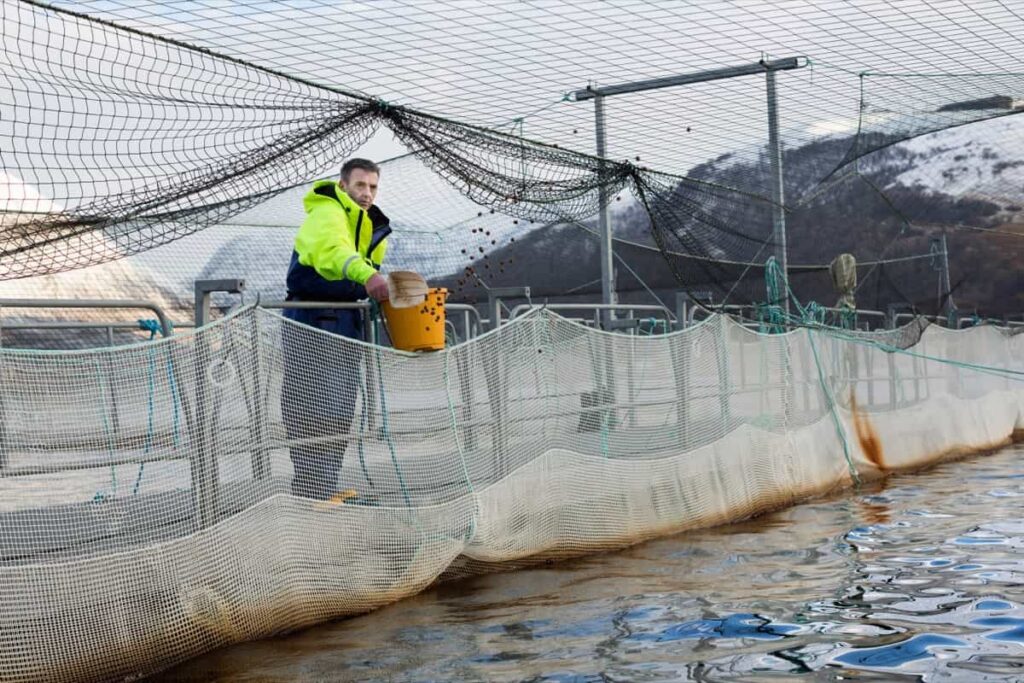
Case Studies of Rice-Fish Farming in Nigeria: Best Approach for Profitability
In Nigeria, severe weather events pose significant challenges to farming and fishing communities due to the arid environment. In 2021, delayed rainfall and subsequent flooding resulted in a substantial harvest reduction and crop loss for farmers in northwestern Nigeria.
Hajia Fatima Aliu joined the Feed the Future Innovation Lab for Fish to protect her livelihood, collaborating with the FAO, the University of Ibadan, and the University of Georgia. Aliu embraced integrated rice-fish farming, growing rice and fish in an aquatic ecosystem. This approach reduced greenhouse gas emissions, enhanced food supply, and improved nutrition for her community.
The project established research plots and shared these techniques with Aliu’s community, empowering her as a role model for integrated rice-fish farming. By combining rice farming with fish cultivation, Aliu increased her income and contributed to environmental sustainability and climate resilience. She now shares her knowledge and experiences to benefit other women and families in her community.
Conclusion
The rise of fish farming in Nigeria presents promising opportunities for entrepreneurs. To start from scratch, aspiring fish farmers should focus on obtaining necessary permits, selecting suitable fish species, securing adequate resources, implementing proper management practices, and ensuring compliance with regulations.
- Sheep Farming Business Plan for Beginners
- Aquaponic Farming at Home: A Step-By-Step Guide
- Profitable Village Farming Business Ideas in 2024
- High-Yield Aquaculture: Fast-Growing Fish for Farming
- Effective Fish Pond Construction Techniques for Beginners
- Irrigation and Water Management in Pineapple Farming
- Blossom to Harvest: Mastering Flowering and Pollination in Papaya Farming
- Pig Fattening Essentials: From Selection to Sale for Beginners
- Raising Wagyu Cattle: A Complete Guide for Premium Beef Production
- Soil Types and Their Water Holding Capacity
- Optimizing Irrigation Schedules for Coconut Groves for Enhanced Yield
- Espresso Your Garden: Coffee Grounds for Healthier Acid-Loving Plants
- The Best Soil Mix for Snake Plants: How to Mix Your Own Snake Plant Soil
- Green Thumb Success: Expert Tips for Cultivating Greenhouse Beans All Year Round
- Bloom All Year Round: The Ultimate Guide to Indoor Hyacinth Care
- Eco-Friendly Gardening: How to Make Liquid Fertilizer from Kitchen Waste
- Ultimate Guide to Grow Anise in Pots: Explore Seed Propagation to Harvesting
- Guide to Raising Chester White Pigs: Discover Breed Facts to Growth Management
- Mastering the Elegance: The Ultimate Guide to Weeping Cherry Tree Care, Planting, and Maintenance
- Ultimate Guide to Planting Garlic in Grow Bags: Growing Strategies for Beginners
- How to Fix Spider Plant Leaf-Related Problems: Natural and Organic Remedies
- 10 Reasons Why Your Tulsi Plant is Shedding Leaves: Home Remedies and Solutions
- Optimizing Growth and Yield: The Advantages of Palm Bunch Ash Fertilizer
- Utilizing Neem Oil Extract as a Natural Pesticide for Hydrangea
- From Soil to Harvest: Various Ways in Which Farmers Can Use AI Tools
- Steps to Encourage and Induce Citrus Flowers: A Comprehensive Guide
- How to Fix Snake Plant Leaf-Related Issues: Natural and Organic Remedies
- Transform Your Garden into a Fragrant Oasis with Raat Ki Rani (Night Blooming Jasmine)
- Discover the Ideal Chicken Breeds for Philippine Farms
- How to Create a Poultry Egg Farm Business Plan for Profits
- Grow Lemon Cucumbers Like a Pro: Insider Techniques for Bountiful Yields
- Ultimate Guide to Caring for Your Pink Princess Philodendron: Tips for Thriving Variegation
- Areca Nut Profit Per Acre: Calculating Yield and Cost of Cultivation
- How Kaveri Chicken is Becoming a More Profitable Breed in Indian Backyards
- Transform Your Barn: 9 Steps to Convert a Horse Stall into a Chicken Coop
- Exploring Suffolk Sheep Disadvantages with Limitations and Challenges
